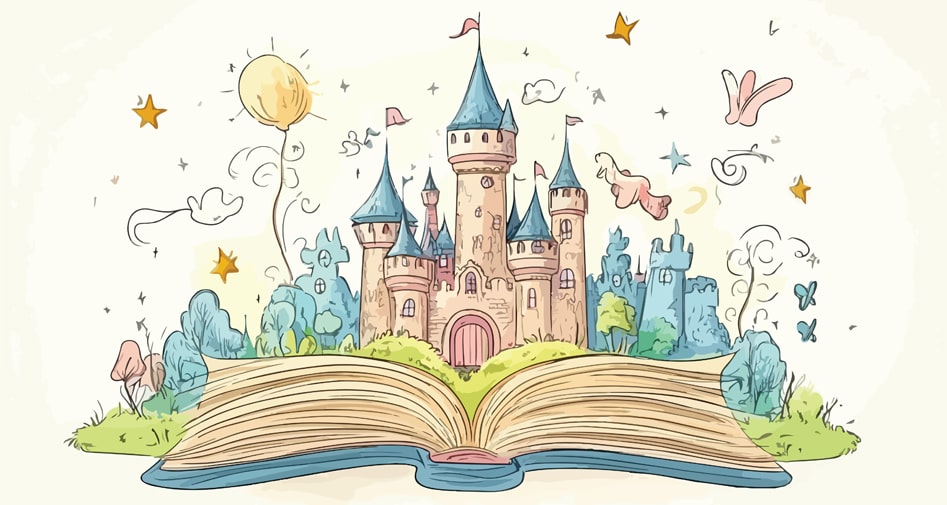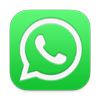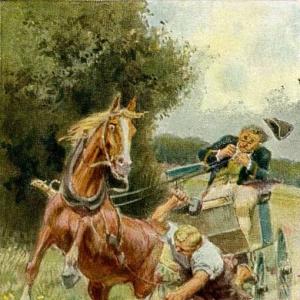Reading time for children: 9 min
There was once an enchantress, who had three sons who loved each other as brothers, but the old woman did not trust them, and thought they wanted to steal her power from her. So she changed the eldest into an eagle, which was forced to dwell in the rocky mountains, and was often seen sweeping in great circles in the sky. The second, she changed into a whale, which lived in the deep sea, and all that was seen of it was that it sometimes spouted up a great jet of water in the air. Each of them only bore his human form for only two hours daily. The third son, who was afraid she might change him into a raging wild beast a bear perhaps, or a wolf, went secretly away. He had heard that a King’s daughter who was bewitched, was imprisoned in the Castle of the Golden Sun, and was waiting for deliverance. Those, however, who tried to free her risked their lives; three-and-twenty youths had already died a miserable death, and now only one other might make the attempt, after which no more must come. And as his heart was without fear, he caught at the idea of seeking out the Castle of the Golden Sun. He had already travelled about for a long time without being able to find it, when he came by chance into a great forest, and did not know the way out of it. All at once he saw in the distance two giants, who made a sign to him with their hands, and when he came to them they said, „We are quarrelling about a cap, and which of us it is to belong to, and as we are equally strong, neither of us can get the better of the other. The small men are cleverer than we are, so we will leave the decision to thee.“ – „How can you dispute about an old cap?“ said the youth. „Thou dost not know what properties it has! It is a wishing-cap; whosoever puts it on, can wish himself away wherever he likes, and in an instant he will be there.“ – „Give me the cap,“ said the youth, „I will go a short distance off, and when I call you, you must run a race, and the cap shall belong to the one who gets first to me.“ He put it on and went away, and thought of the King’s daughter, forgot the giants, and walked continually onward. At length he sighed from the very bottom of his heart, and cried, „Ah, if I were but at the Castle of the Golden Sun,“ and hardly had the words passed his lips than he was standing on a high mountain before the gate of the castle. He entered and went through all the rooms, until in the last he found the King’s daughter. But how shocked he was when he saw her. She had an ashen-gray face full of wrinkles, blear eyes, and red hair. „Are you the King’s daughter, whose beauty the whole world praises?“ cried he. „Ah,“ she answered, „this is not my form; human eyes can only see me in this state of ugliness, but that thou mayst know what I am like, look in the mirror it does not let itself be misled it will show thee my image as it is in truth.“ She gave him the mirror in his hand, and he saw therein the likeness of the most beautiful maiden on earth, and saw, too, how the tears were rolling down her cheeks with grief. Then said he, „How canst thou be set free? I fear no danger.“ She said, „He who gets the crystal ball, and holds it before the enchanter, will destroy his power with it, and I shall resume my true shape. Ah,“ she added, „so many have already gone to meet death for this, and thou art so young. I grieve that thou shouldst encounter such great danger.“ – „Nothing can keep me from doing it,“ said he, „but tell me what I must do.“ – „Thou shalt know everything,“ said the King’s daughter; „when thou descendest the mountain on which the castle stands, a wild bull will stand below by a spring, and thou must fight with it, and if thou hast the luck to kill it, a fiery bird will spring out of it, which bears in its body a burning egg, and in the egg the crystal ball lies like a yolk. The bird will not, however, let the egg fall until forced to do so, and if it falls on the ground, it will flame up and burn everything that is near, and melt even ice itself, and with it the crystal ball, and then all thy trouble will have been in vain.“
The youth went down to the spring, where the bull snorted and bellowed at him. After a long struggle he plunged his sword in the animal’s body, and it fell down. Instantly a fiery bird arose from it, and was about to fly away, but the young man’s brother, the eagle, who was passing between the clouds, swooped down, hunted it away to the sea, and struck it with his beak until, in its extremity, it let the egg fall. The egg did not, however, fall into the sea, but on a fisherman’s hut which stood on the shore and the hut began at once to smoke and was about to break out in flames. Then arose in the sea waves as high as a house, they streamed over the hut, and subdued the fire. The other brother, the whale, had come swimming to them, and had driven the water up on high. When the fire was extinguished, the youth sought for the egg and happily found it. It was not yet melted, but the shell was broken by being so suddenly cooled with the water, and he could take out the crystal ball unhurt.
When the youth went to the enchanter and held it before him, the latter said, „My power is destroyed, and from this time forth thou art the King of the Castle of the Golden Sun. With this canst thou likewise give back to thy brothers their human form.“ Then the youth hastened to the King’s daughter, and when he entered the room, she was standing there in the full splendour of her beauty, and joyfully they exchanged rings with each other.
 Learn languages. Double-tap on a word.Learn languages in context with Childstories.org and Deepl.com.
Learn languages. Double-tap on a word.Learn languages in context with Childstories.org and Deepl.com.Backgrounds
Interpretations
Adaptions
Summary
Linguistics
„The Crystal Ball“ is a German fairy tale collected by the Brothers Grimm, who were linguists, cultural researchers, and authors. Jacob and Wilhelm Grimm were born in the late 18th century and lived through the early 19th century in Germany. They are best known for their collection of fairy tales, which were part of a larger project to preserve Germanic folklore, literature, and traditions during a time when the country was undergoing significant cultural change.
The Brothers Grimm published their first volume of fairy tales, „Children’s and Household Tales“ (in German: „Kinder- und Hausmärchen“), in 1812. The book underwent multiple revisions, with new stories added and others removed, culminating in the final edition published in 1857. In total, the collection includes over 200 stories, featuring popular tales such as „Cinderella,“ „Hansel and Gretel,“ „Rapunzel,“ and „Snow White.“
„The Crystal Ball“ is among the lesser-known stories in the Brothers Grimm collection. Like many other Grimm fairy tales, it draws on oral storytelling traditions and earlier written sources. The story presents several familiar fairy tale themes, such as transformation, the quest for true love, trials and challenges, and the triumph of good over evil. Although the exact origins of „The Crystal Ball“ are uncertain, its narrative structure and motifs are consistent with many other European folktales and fairy tales.
„The Crystal Ball“ can be interpreted in several ways, with different themes and motifs emerging from the narrative:
Power and fear: The enchantress, fearing her sons might steal her power, transforms two of them into animals. Her actions illustrate the corrupting influence of power and the destructive nature of fear.
The quest for true love: The youngest son embarks on a dangerous journey to save the bewitched King’s daughter, despite the risks involved. This quest demonstrates the transformative power of love, as it inspires courage and selflessness in the protagonist.
Inner beauty and deception: The King’s daughter is seen by human eyes as old and ugly, but her true beauty is revealed through a mirror. This motif highlights the importance of looking beyond appearances to find the truth and the essence of a person’s character.
Trials and personal growth: The protagonist faces several trials in his quest, such as battling the bull and retrieving the crystal ball. Through these challenges, he grows stronger, more resilient, and gains the necessary wisdom to succeed in his mission.
The power of unity and cooperation: The protagonist’s brothers, the eagle and the whale, help him capture the egg and retrieve the crystal ball, despite their enchantress mother’s actions. This emphasizes the importance of family, unity, and teamwork in overcoming obstacles.
The reversal of fortunes: By defeating the enchantress and retrieving the crystal ball, the protagonist restores the King’s daughter’s beauty and his brothers‘ humanity. This turn of events exemplifies the possibility of redemption, transformation, and the triumph of good over evil.
„The Crystal Ball“ has inspired various adaptations over the years. Here are a few examples.
Stage adaptations: „The Crystal Ball“ has been adapted for the stage in various forms, including ballets, plays, and musicals. For example, the ballet „The Crystal Ball“ was first performed in 1967 by the Royal Ballet in London.
Film adaptations: „The Crystal Ball“ has been adapted for film several times, including the 1956 French film „La Belle et la Bête“ (Beauty and the Beast), which features a storyline similar to „The Crystal Ball“.
Novel adaptations: „The Crystal Ball“ has also inspired novels, such as Sibylle Bedford’s „Crystal Ball“ (1989), which reimagines the story in a modern setting.
TV adaptations: „The Crystal Ball“ has been adapted for television, such as in the episode „The Crystal Ball“ from the animated TV series „Faerie Tale Theater“ (1982), which retells the story with a few twists.
Interactive adaptations:0 „The Crystal Ball“ has also been adapted into interactive media, such as video games. For example, the game „Grim Legends 3: The Dark City“ (2014) is loosely based on the story of „The Crystal Ball“.
These adaptations have allowed audiences to experience „The Crystal Ball“ in new and different ways, while still capturing the essence of the original fairy tale.
„The Crystal Ball“ is a fairy tale by Brothers Grimm about an enchantress with three sons who, fearing her power might be stolen, turns two of them into animals while the third runs away. The youngest son hears of a bewitched King’s daughter imprisoned in the Castle of the Golden Sun, and decides to find the castle to save her. After many trials, he encounters two giants arguing over a magical wishing-cap, which they give to him after a clever trick. Using the cap, he finds the Castle of the Golden Sun and discovers the King’s daughter appears old and ugly, but her true beauty is shown in a mirror.
To break her curse, the youth must retrieve a crystal ball from inside a burning egg, which is inside a fiery bird, which arises from a wild bull. After a fierce battle, he kills the bull, and his brothers (an eagle and a whale) help him capture the egg and retrieve the crystal ball. Confronting the enchantress, he destroys her power with the crystal ball, becomes the King of the Castle of the Golden Sun, and restores his brothers‘ human forms. The King’s daughter regains her true beauty, and she and the youth happily exchange rings, uniting their fates.
The fairy tale „The Crystal Ball“ by the Brothers Grimm presents a rich tapestry for linguistic analysis, offering insight into the narrative structure, character roles, motifs, and themes common to the fairy tale genre.
Narrative Structure and Character Roles
Stock Characters: The tale follows the traditional structure of fairy tales with clear archetypal characters. These include the *enchantress* (the antagonist), her three *sons* (the protagonists, each with a specific role), and the *King’s daughter* (the damsel in distress).
Hero’s Journey: The third son embodies the classic hero archetype, embarking on a quest that involves challenges, magical objects, and transformation. This aligns with Joseph Campbell’s monomyth or the „hero’s journey,“ where the protagonist ventures out, faces trials, and returns transformed.
Supporting Characters: The brothers transformed into an eagle and a whale each play crucial roles in aiding the hero, highlighting the theme of brotherly cooperation and unity against adversity. The giants, though initially incidental, introduce an essential plot device: the wishing-cap.
Motifs and Themes
Transformation and Restoration: Transformation is a recurring motif. The enchantress turns her sons into animals, embodying mistrust and misuse of power. However, these transformations also become advantageous. The theme of restoration is culminated in the hero’s quest to break the enchantment over the King’s daughter, emphasizing themes of redemption and the return to true form.
Quests and Tests: The quest for the crystal ball involves trials that the protagonist must overcome, such as fighting a bull and capturing a magical egg. These tests are typical of the fairy tale genre and serve to prove the hero’s courage and worthiness.
Magic Objects: Magical elements like the wishing-cap and crystal ball are central motifs that drive the narrative. They symbolize power, destiny, and the fulfillment of wishes or objectives central to the plot’s resolution.
Bravery and Sacrifice: The third son’s fearless nature and willingness to face danger for love and restoration underscores the theme of bravery.
Fraternal Loyalty: The storyline also celebrates familial bonds, as the brothers, despite their transformations, assist one another. This collective effort is pivotal in the hero’s success.
Use of Direct Speech: Dialogue is instrumental in moving the plot forward and revealing character motives. Direct speech, seen in conversations with the giants, the King’s daughter, and the enchanter, is a hallmark of fairy tales, making them engaging and dynamic.
Descriptive Language: Vivid descriptions, such as the eagle’s flight and the whale’s aquatic actions, create a magical and expansive setting. The transformation of the King’s daughter, displayed through contrasting imagery of her ugly, enchanted form and true beauty, emphasizes the impact of external appearances and internal truth.
Simple Sentence Structure: The story employs a straightforward sentence structure typical of fairy tales, ensuring accessibility and a focus on storytelling.
Repetition and Patterning: Structural repetition, such as the description of trials or the sequential actions of the brothers, provides rhythm and predictability, key features in oral storytelling traditions.
Moral and Didactic Elements: Implicit moral lessons, like the triumph of good over evil and the rewards of bravery and loyalty, are woven throughout the narrative, characteristic of Grimm fairy tales.
In summary, „The Crystal Ball“ exemplifies the Grimm Brothers‘ adeptness at constructing a fairy tale replete with symbolic motifs, a compelling hero’s journey, and linguistic simplicity, all woven together to convey timeless themes of bravery, transformation, and familial unity.
Information for scientific analysis
Fairy tale statistics | Value |
|---|---|
| Number | KHM 197 |
| Aarne-Thompson-Uther-Index | ATU Typ 552A |
| Translations | DE, EN, ES, PT, HU, IT, JA, NL, PL, RU, TR, VI, ZH |
| Readability Index by Björnsson | 34.5 |
| Flesch-Reading-Ease Index | 77.4 |
| Flesch–Kincaid Grade-Level | 8.6 |
| Gunning Fog Index | 11.3 |
| Coleman–Liau Index | 7.3 |
| SMOG Index | 8.7 |
| Automated Readability Index | 9.3 |
| Character Count | 5.542 |
| Letter Count | 4.242 |
| Sentence Count | 44 |
| Word Count | 1.083 |
| Average Words per Sentence | 24,61 |
| Words with more than 6 letters | 107 |
| Percentage of long words | 9.9% |
| Number of Syllables | 1.337 |
| Average Syllables per Word | 1,23 |
| Words with three Syllables | 40 |
| Percentage Words with three Syllables | 3.7% |

 Facebook
Facebook  Whatsapp
Whatsapp  Messenger
Messenger  Telegram
Telegram Reddit
Reddit














